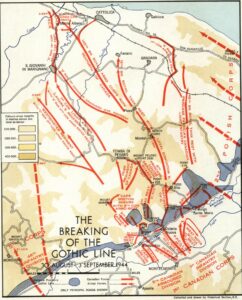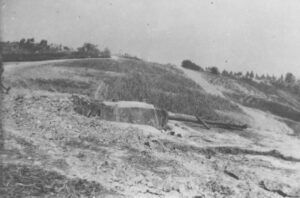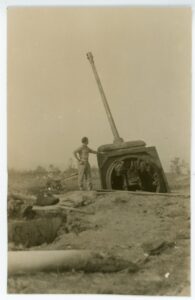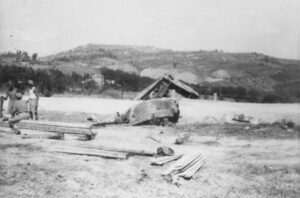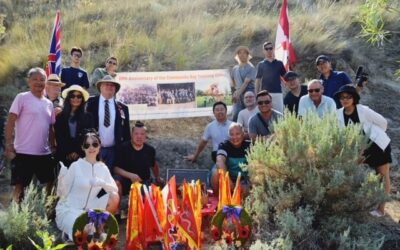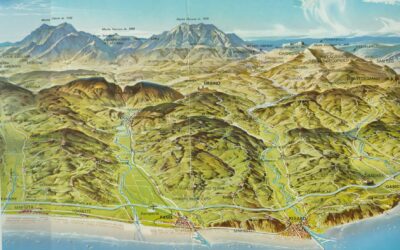In Part I, we followed the 9th Canadian Armoured Regiment (British Columbia Dragoons), of the 5th Canadian Armoured Division, down into the Foglia River valley to breach the German defences of the Gothic Line above Montecchio and into the highlands around Tomba di Pesaro, Italy on August 31, 1944. According to the personal account of Lieutenant Zenon M. “Zeke” Ferley, he was stranded on the battlefield near Point 204 having lost his tank to anti-tank fire and taking refuge with his crew from roaming German vehicle and foot patrols, waiting for night fall. He was troop leader for 3rd Troop, C Squadron that had been tasked to roll through A Squadron out of the harbour area near Montecchio and advance to their objective, Point 204 while A Squadron dealt with the unexpected presence of German infantry in the harbour and B Squadron waiting for the infantry of the Perth Regiment to appear.
Part II will track other events, units and outcomes.
The infantry of the Cape Breton Highlanders was to take Montecchio during the night of August 30/31 while the Perth Regiment was to advance into the Gothic Line and take Point 111. Meanwhile, to the east the Princess Patricia’s Canadian Light Infantry were to push through at Osteria Nuova and into the hills beyond. The Highlanders were and the Perths were subjected to enemy artillery and mortar fire while penetrating the minefields after a long night march.
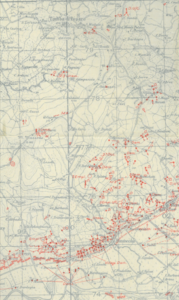
Intelligence map of German defences between Montecchio and Osteria Nuova showing minefields, trenches, troop concentrations, machine gun posts, and fortifications. BCD-C-501f cropped
in 18 Platoon, D Company of the Perth Regiment in the 11th Canadian Infantry Brigade, 5th Canadian Armoured Division. Scislowski recalls,
“The Regiment was supposed to have married up with the tanks of the BCD earlier in the day [August 31], in a thrust that was to take us through the rolling countryside to Point 204 two miles to the northeast, the linchpin in the Gothic Line.” 1
As the BCDs moved across the Foglia floodplain and encountered the Germans in their designated harbour area, the Perths were held up by heavy artillery and fatigue. Pushed by higher command to keep moving Lieutenant Colonel F. A. Vokes, Commanding Officer 9th CAR (BCD), decided that given the confusion of the enemy encounter in the harbour that they would proceed without the infantry support in the hope that the Perths would join the fight as best they could.
German infantry used portable anti-tank launchers called Panzerfausts to attack tanks. Another type of German defence works was the Panzerturms that were concrete bunkers with Panther tank turrets mounted on top that were cleverly camouflaged and low to the ground with excellent fields of fire, especially for tanks coming up over ridge lines and along roads. The Canadian infantry faced concrete machine gun fortifications and slit trenches.
“Once the tanks broke loose, they went on a rampage, catching enemy reserves rushing up on the roads, wagon tracks, and in open fields, blasting through with their 75s [75mm main guns] and ripping apart whole platoons with the hull mounted machine guns. They barged their way through narrow gullies and across farmyards, all weapons banging away at anything that might have a strongpoint or anti-tank gun. Within an hour after elements of the BCDs gained control of the dominating feature, Vokes took his RHQ [Regimental Headquarters] troop consisting of four tanks and roared off to see how his forward squadrons were making out. Shortly thereafter they passed through an area left of the hill where the enemy had dug in. Three of the tanks including Vokes’ unarmed command tank were destroyed. The CO managed to bail out and climbed onto the rear deck of the remaining runner which eventually arrived at Point 204” 2
Soon after, at a farmhouse on Point 204, Vokes was severely injured by heavy mortar and artillery fire while meeting with his squadron commanders. Lieutenant Colonel F. A. Vokes died of his wounds later in the evening.
For the BCDs, “The position was very difficult, and a counterattack appeared imminent. Reduced to 12 tanks, A and C Squadrons held on for 5 hours without infantry support until relieved at 1900 hrs by LdSH and Perth R who had to fight their way. They also had orders that this important position had to be held at all costs.” 3
“All the way up the slope to this point, the BCD had had tanks hit including most of their RHQ tanks, and the squadron which had finally reached PT 322 [aka Point 204] was in no fit condition to hold it. It was indeed a hard day for the ‘Appleknockers,’ who encountered heavy opposition from all sorts of weapons including accurately observed shelling from heavy calibres. Shortly after 1400 hours, the Brigadier ordered the LdSH to proceed as quickly as possible to PT 322 to relieve the BCD.” 4
The Perth Regiment followed the tanks of the Lord Strathcona’s Horse (Royal Canadians) (LdSH) on foot and arrived by last light. Together they provided a tough defence against counterattacks on the night of August 31 and September 1. The next day they attacked PT 355 [Hill 253] near the village of Tomba di Pesaro.
Meanwhile, Lieutenant Zenon M. “Zeke” Ferley and his four crew members were sheltering in a ditch near their destroyed tank, heard a vehicle approach. It was a German Red Cross vehicle, and the driver pulled up right beside the men. Ferley and the driver stared at each other for a while until the driver drove off the way he came. Soon after a group of German paratroopers could be heard coming down the trail. Thankfully, the four Germans were being escorted by Trooper Garnet of 4th Troop. Together in the late afternoon, they cautiously made their way back down towards the river to the safety of fellow Canadians.
The BCDs regrouped near the original harbour area and defended it against enemy infantry attacks all night with only 18 running tanks. Regimental Headquarters had been wiped out with all its communications, maps, codes, and equipment. Lieutenant Colonel Harry Angle, a BCD militia officer who led the bridge guard details in BC in 1939, returned from Brigade HQ to take command, get the runners replenished, the crews fed and ready to fight at once while the recovery of disabled tanks proceeded. Within 24 hours they had 44 tanks ready for duty. They would be called to support the infantry attacking Coriano Ridge from September 3 to 10 before being relieved.
The 9th Canadian Armoured Regiment (British Columbia Dragoons) suffered 51 officers and men killed or wounded during this action from August 29 to September 3, 1944.5 Three are remembered on Okanagan cenotaphs: Trooper Roy Vicars Atkinson of Penticton, Trooper Stanley Charles Saunders of Kelowna, and Trooper Nicholas Schmidt of Rutland.
1] Not All of Us Were Brave – Perth Regiment, Stanley Scislowski, Dundurn Press Toronto, 1997 pgs. 263 > 266.
2] Ibid.
3] 9th CAR (BCD) War Diary, lac reel T12693 https://heritage.canadiana.ca/view/oocihm.lac_reel_t12693/423
4] Lord Strathcona’s Horse (Royal Canadians) Record of Achievement, J. McAvity 1947, pg. 120
5] Sinews of Steel a History of the British Columbia Dragoons, RH Roy, Charters Publ. Co. Ltd Toronto 1965 pg. 305
Maps
M 1] Map # 19 The Breaking of the Gothic Line 30 August to 3 September 1944, Canadians in Italy – Official History of the Canadian Army in the Italian Campaign, Lt Col GWL Nicholson, MoD Ottawa 1956.
M 2] Intelligence map 1/25 000, BCD-C-501f cropped
Online resources
Project ’44 Canadian Army mapping website with formation to unit level war diaries to follow events on the battlefields of the Second World War: https://map.project44.ca/

